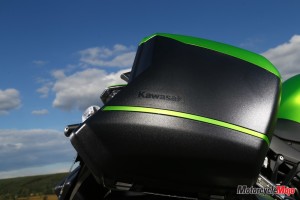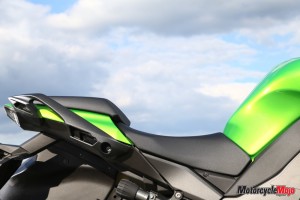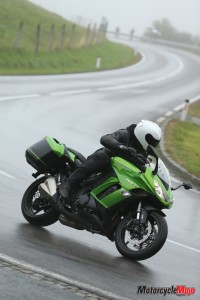Jaded on sport bikes? Not ready for a full-blown tourer and giant trailies don’t quite tickle your fancy? Well, how about a motorcycle that eats up traffic and kilometres quickly and in comfort? Add protection from the elements and the security of ABS and traction control, and you’re ready for a spin through Austria.
With its capable, yet comfortable chassis, 136 hp, 81 ft-lb of torque and multiple touring features, the Ninja 1000 has allowed the average Joe to keep his profile low and pace high since 2011. Keeping its position as Kawasaki’s sportiest, sport-tourer, the newly revised model improves on its already good manners with the inclusion of ABS and traction control.
This year, the Ninja 1000 is available in candy cascade blue or candy lime-green with optional, lockable and removable monokey side panniers, both can stomach about 28 litres of luggage. While less than last year’s 35, it is still enough to swallow a full-face lid and a soon to be needed rain suit.
The presumably stunning Austrian landscape and twisty roads are camouflaged by gray overcast skies and drizzle; a playlist of wet crashes plays in the back of my mind. “Come now,” urges the Ninja 1000’s project leader, Makoto Momosaki. “This year you can choose from two different power modes and three traction-control settings. In “high”, you’ll get all the oomph, but once you flick the switch to “low,” the power is reduced to 70%. You’ll be ok. Besides, it’s got ABS as standard.” Makoto-san is a good builder of confidence.
The ergonomics join in, soothing my bum with a sturdy, yet narrow, reshaped seat, and helping me find my feet with ease. The peg position is mildly sporty, while the broad, straightish handlebars are set quite close to the dash, kneading my arms in a relaxed position, and the mirrors have been mounted wider apart and higher up for better rear vision. Even the four pistons whirr smoothly – zen-like – underneath the 19-litre fuel tank.
 An analog tach, a digital speedo with double trip computer, and a digital clock provide the basics, but the Ninja also informs you about your fuel range, the average or current fuel consumption, the selected traction-control mode and the engine mapping. To adjust these last two, you won’t have to dive into the dash; a quick push on the button cluster to your left will do the trick.
An analog tach, a digital speedo with double trip computer, and a digital clock provide the basics, but the Ninja also informs you about your fuel range, the average or current fuel consumption, the selected traction-control mode and the engine mapping. To adjust these last two, you won’t have to dive into the dash; a quick push on the button cluster to your left will do the trick.
With Makoto-san’s voice ringing in my ears, I realize today’s ride is about technique – that’s what this rainfest will boil down to. I’m the limiting factor. At the start of our 240 km ride, both the bike and I remain relaxed, thanks to a smooth, progressive clutch and an easygoing gearbox. The first 6000 rpm are so polite that you can casually roll through the city centre in top gear without even the slightest of hiccups. Semi-automatic gearboxes suddenly seem a bit overrated. As do weather forecasts, because minutes after the first photo shoot, a set of sunbeams sneak past the clouds. Bit by bit, the asphalt dries out and the curvy countryside shows its true beauty.
All morning long, the traction control has been in its third, most meddlesome mode, helping the Bridgestone Battlax S20s hold on. Not that it has had a particularly busy morning. The fully adjustable front end and a ZX 10R–derived rear shock suspend this Ninja stiffer than ever, so the tires offer instant traction feedback. The rear shock also comes with a remote preload adjuster, so with the flick of a wrist, you dial in your setting to suit your load. And in the event of utter rear-wheel euphoria, Kawasaki’s traction-control system subtly intervenes without spoiling the party.
 Speaking of which, the more grip I can muster, the more digits the speedo registers, and as the drivetrain gave me tons of confidence in the wet, I’m beaming with it under this shy sun. My left thumb eagerly searches for full power while my right hand grabs full throttle. The engine, flexible as a rubber band just minutes ago, roars past the 7000 rpm mark with the thrust of a bungee cord, muting my “Yihaaa!” with a mouth-watering intake howl. The intake howl comes courtesy of larger downdraft throttle body intake funnels and a modified ECU and camshaft, these changes are most noticeable in the middle of the rev range.
Speaking of which, the more grip I can muster, the more digits the speedo registers, and as the drivetrain gave me tons of confidence in the wet, I’m beaming with it under this shy sun. My left thumb eagerly searches for full power while my right hand grabs full throttle. The engine, flexible as a rubber band just minutes ago, roars past the 7000 rpm mark with the thrust of a bungee cord, muting my “Yihaaa!” with a mouth-watering intake howl. The intake howl comes courtesy of larger downdraft throttle body intake funnels and a modified ECU and camshaft, these changes are most noticeable in the middle of the rev range.
Welcome, Mr. Hyde. Exploiting its endlessly linear power supply, I’m cannonballing down winding roads at speeds more suited to abandoned highway straights.
Rowing through the smooth-shifting gears bring some added spice to the party. The next thing I know, zero turns to triple digit numbers, and the straight line suddenly switches to an unexpectedly tight right-hander. Luckily, the radial Nissin master brake cylinder and radial-mounted Tokico monoblocs are ready for action; the brake lever only needs one finger to make a significant difference to the position of the speedo’s needle.
Like the engine, the suspension geometry is set up to be a bit more laid back than its sportier nephew, the Z1000. The 41 mm inverted fork eats the bumps. They are fully adjustable allowing you to dial in your preferred compression and preload damping as well as spring preload. The rear is suspended by a horizontally mounted monoshock with a remote preload adjuster and conventional rebound adjustments.
Add to that an aluminum twin-tube frame that combines low weight with high rigidity and the exhaust’s under-engine pre-chamber and its smaller silencers that help to centralize mass and keep the bike from feeling nervous at aggressive cornering angles, at least most of the time. Something felt a little dodgy during rapid direction changes, as in a series of esses. This bike seemed to struggle with its weight in those sections, and it turned in a bit too quickly, just for a fraction of a second – then it was gone. I wasn’t the only one to notice; a few other journos had the same experience. For the rest of the time, the steering was svelte and predictable.
The panniers slide directly onto the aluminum passenger grips, tucking in nicely and causing no fussy turbulence. The bike looks good with or without the panniers mounted. The windscreen tries to stick to the same ethos; in its lowest setting I catch quite a bit of wind, but buffeting is kept at bay. You can raise the three-position windscreen, but I’m still too much in love with life to do this on the move. You have to push a lever buried behind the bars, while jerking the screen in place. That’s why you’ll always need both hands and a set of traffic lights. The job’s done before red turns to green, though.
This Ninja is already a well-rounded companion for sports, touring and spouse. And the package just got a little better behaved, thanks to smart traction and power control. The optional panniers ($1162.44) can turn it into a competent tourer. For $13,999, it is money well spent on a bike that doesn’t have to fear many challengers.
| The basics | |
| List Price | $13,999 |
| Warranty | 12 months, unlimited kilometres |
| Company URL | www.kawasaki.ca |
| Engine Type | Liquid-cooled, inline-four |
| Displacement | 1043 cc |
| The drivetrain | |
| Power (claimed) | 136 hp (101.5 Kw) |
| Torque (claimed) | 81 ft-lb (110 N-m) |
| Bore and Stroke | 77.0 x 56.0 mm |
| Compression Ratio | 11.8:1 |
| Fuel Delivery | Digital fuel injection with four 38 mm Keihin throttle bodies with oval sub-throttles |
| Transmission | 6-speed |
| Final Drive Type | chain |
| The essentials | |
| Front Suspension | 41 mm inverted fork, stepless compression and rebound damping and adjustable preload |
| Rear Suspension | Horizontal back-link, gas charged, with stepless rebound damping and adjustable preload |
| Wheel Travel | Front: 120 mm (4.7 in.); Rear: 138 mm (5.4 in.) |
| Brakes | Front: Dual 300 mm disc with 4-piston calipers; |
| Rear: Single 250 mm disc with single-piston caliper | |
| Wheelbase | 1445 mm (56.9 in.) |
| Rake and Trail | 24.5 degrees/102 mm |
| Tires | Front: 120/70-ZR-17; Rear: 190/50-ZR-17 |
| Weight (wet) | 228 kg (502.4 lb.) |
| Seat Height | 820 mm (32.3 in.) |
| Fuel Capacity | 19 litres |
| Fuel Economy | N/A |
| Fuel Range | N/A |



























